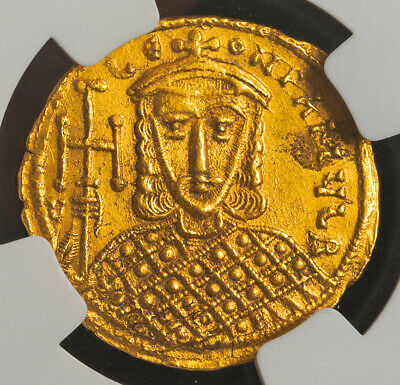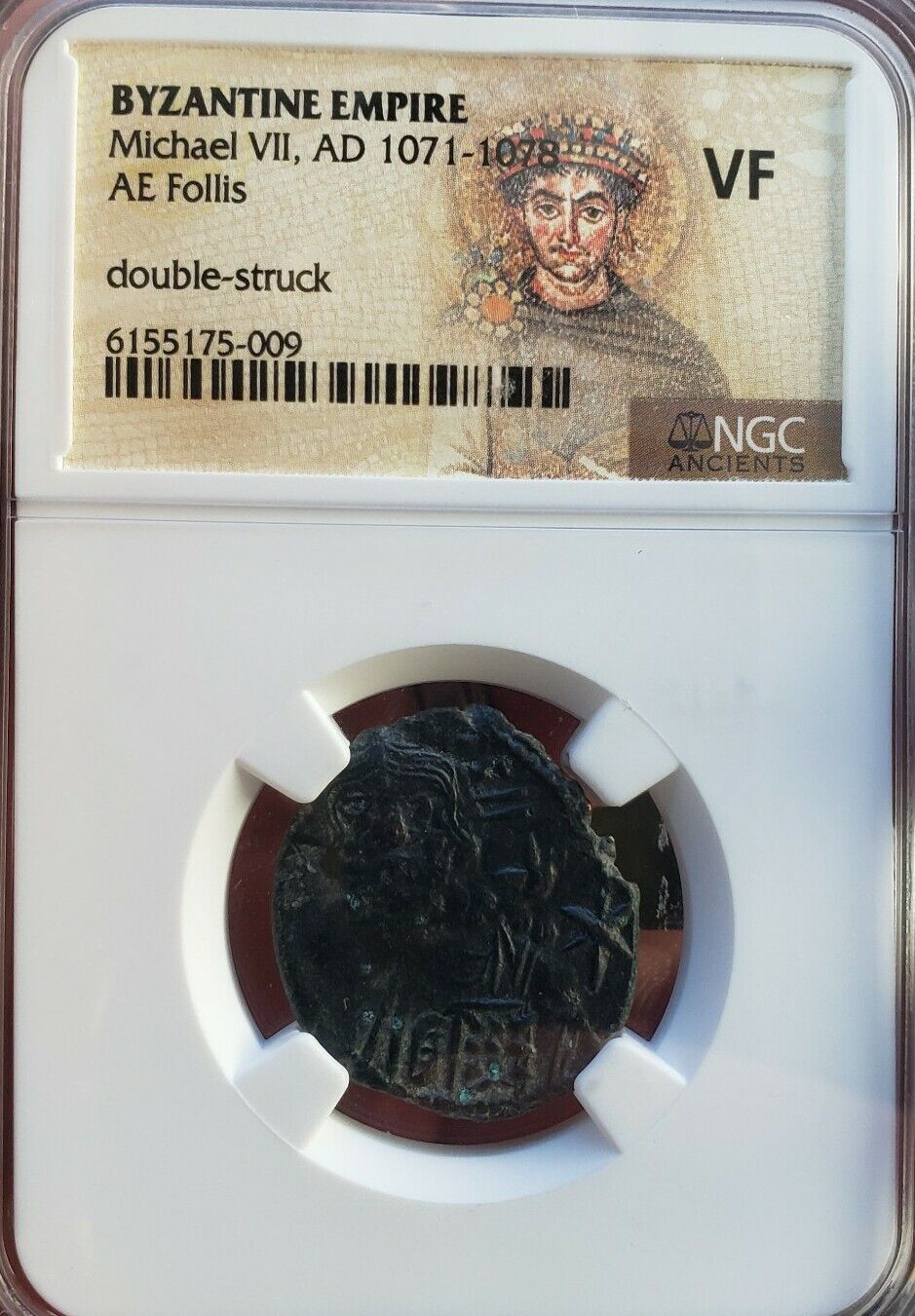-40%
775, Constantine V, with Leo III & Leo IV. Gold Solidus (4.43gm!) NGC Choice AU!
$ 1120.93
- Description
- Size Guide
Description
CoinWorldTV775, Constantine V, with Leo III & Leo IV. Gold Solidus (4.43gm!) NGC Choice AU!
Mint Place: Constantinople
Denomination: Gold Solidus
Mint Period: Struck 773-14 September 775.
Provenance:
NAC 100 (29th May 2017), lot 2054.
Reference: Friedberg 172, DOC 2c, Sear 1551.
Rare!
Condition:
Certified and graded by NGC as Choice AU!
Rulers: Constantine V Copronymus, with Leo IV and Leo III. (750-775 AD)
Diameter: 21mm
Weight: 4.43gm
Material: Gold!
Obverse:
Crowned bust of Leo III facing, wearing loros, holding cross potent. Sigla (B) at the end of legend.
Legend: C LЄON P A MЧL (B)
Reverse:
Crowned facing bust of Constantine, beardless, wearing chlamys pinned at right shoulder, holding cross potent in right hand and akakia in left.
Legend: COҺSƮAҺƮIҺOS S LЄOҺ O ҺЄOS
Authenticity unconditionally guaranteed.
Buy with confidence!
Constantine V
(Greek:
Κωνσταντῖνος
, translit.
Kōnstantīnos
; July 718 – 14 September 775 AD) was Byzantine emperor from 741 to 775. His reign saw a consolidation of Byzantine security from external threats. As an able military leader, Constantine took advantage of civil war in the Muslim world to make limited offensives on the Arab frontier. With this eastern frontier secure, he undertook repeated campaigns against the Bulgars in the Balkans. His military activity, and policy of settling Christian populations from the Arab frontier in Thrace, made Byzantium's hold on its Balkan territories more secure.
Religious strife and controversy was a prominent feature of his reign. His fervent support of Iconoclasm and opposition to monasticism led to his vilification by later Byzantine historians and writers, who denigrated him as
Kopronymos
or
Copronymus
(Κοπρώνυμος), meaning
the dung-named
.
Leo III the Isaurian
also known as
the Syrian
(Greek: Λέων Γ΄ ὁ Ἴσαυρος,
Leōn III ho Isauros
), (
c.
685 – 18 June 741) was Byzantine Emperor from 717 until his death in 741. He put an end to a period of instability, successfully defended the Empire against the invading Umayyads, and forbade the veneration of icons.
Leo, whose original name was
Konon
, was born in Germanikeia in the Syrian province of Commagene (modern Kahramanmaraş in Turkey). Some, including the Byzantine chronicler Theophanes, have claimed that Konon's family had been resettled in Thrace, where he entered the service of Emperor Justinian II, when the latter was advancing on Constantinople with an army of 100,000 horsemen provided by Tervel of Bulgaria in 705.
After the victory of Justinian II, Konon was dispatched on a diplomatic mission to Alania and Lazica to organize an alliance against the Umayyad Caliphate under Al-Walid I. Konon was appointed commander (
stratēgos
) of the Anatolic theme by Emperor Anastasius II. On his deposition, Konon joined with his colleague Artabasdus, the
stratēgos
of the Armeniac theme, in conspiring to overthrow the new Emperor Theodosius III. Artabasdus was betrothed to Anna, daughter of Leo as part of the agreement.
Leo entered Constantinople on 25 March 717 and forced the abdication of Theodosios III, becoming emperor as Leo III. The new Emperor was immediately forced to attend to the Second Arab siege of Constantinople, which commenced in August of the same year. The Arabs were Umayyad forces sent by Caliph Sulayman ibn Abd al-Malik and serving under his brother Maslama ibn Abd al-Malik. They had taken advantage of the civil discord in the Byzantine Empire to bring a force of 80,000 to 150,000 men and a massive fleet to the Bosphorus.
Careful preparations, begun three years earlier under Anastasius II, and the stubborn resistance put up by Leo wore out the invaders. An important factor in the victory of the Byzantines was their use of Greek fire. The Arab forces also fell victim to Bulgarian reinforcements arriving to aid the Byzantines. Leo was allied with the Bulgarians but the chronicler Theophanes the Confessor was uncertain if they were still serving under Tervel of Bulgaria or his eventual successor Kormesiy of Bulgaria.
Unable to continue the siege in the face of the Bulgarian onslaught, the impenetrability of Constantinople's walls, and their own exhausted provisions, the Arabs were forced to abandon the siege in August, 718. Sulayman himself had died the previous year and his successor Umar II would not attempt another siege. The siege had lasted 12 months.
Having thus preserved the Empire from extinction, Leo proceeded to consolidate its administration, which in the previous years of anarchy had become completely disorganized. In 718 he suppressed a rebellion in Sicily and in 719 did the same on behalf of the deposed Emperor Anastasios II.
Leo secured the Empire's frontiers by inviting Slavic settlers into the depopulated districts and by restoring the army to efficiency; when the Umayyad Caliphate renewed their invasions in 726 and 739, as part of the campaigns of Hisham ibn Abd al-Malik, the Arab forces were decisively beaten, particularly at Akroinon in 740. His military efforts were supplemented by his alliances with the Khazars and the Georgians.
Leo undertook a set of civil reforms including the abolition of the system of prepaying taxes which had weighed heavily upon the wealthier proprietors, the elevation of the serfs into a class of free tenants and the remodelling of family, maritime law and criminal law, notably substituting mutilation for the death penalty in many cases. The new measures, which were embodied in a new code called the
Ecloga
(
Selection
), published in 726, met with some opposition on the part of the nobles and higher clergy. The Emperor also undertook some reorganization of the theme structure by creating new themata in the Aegean region.
Leo's most striking legislative reforms dealt with religious matters, especially iconoclasm ("Icon-breaking," therefore an iconoclast is an "Icon-breaker"). After an apparently successful attempt to enforce the baptism of all Jews and Montanists in the empire (722), he issued a series of edicts against the worship of images (726–729). This prohibition of a custom which had been in use for centuries seems to have been inspired by a genuine desire to improve public morality, and received the support of the official aristocracy and a section of the clergy. A majority of the theologians and all the monks opposed these measures with uncompromising hostility, and in the western parts of the Empire the people refused to obey the edict.
A revolt which broke out in Greece, mainly on religious grounds, was crushed by the imperial fleet in 727 (cf. Agallianos Kontoskeles). In 730, Patriarch Germanos I of Constantinople resigned rather than subscribe to an iconoclastic decree. Leo had him replaced by Anastasios, who willingly sided with the Emperor on the question of icons. Thus Leo suppressed the overt opposition of the capital.
In the Italian Peninsula, the defiant attitude of Popes Gregory II and Gregory III on behalf of image-veneration led to a fierce quarrel with the Emperor. The former summoned councils in Rome to anathematize and excommunicate the iconoclasts (730, 732); In 740 Leo retaliated by transferring Southern Italy and Illyricum from the papal diocese to that of the Patriarch of Constantinople. The struggle was accompanied by an armed outbreak in the exarchate of Ravenna in 727, which Leo finally endeavoured to subdue by means of a large fleet. But the destruction of the armament by a storm decided the issue against him; his southern Italian subjects successfully defied his religious edicts, and the Exarchate of Ravenna became effectively detached from the Empire.
The emperor died of dropsy in June 741.
Leo IV the Khazar
(Greek: Λέων Δ΄ ὁ Χάζαρος,
Leōn IV ho Khazaros
; 25 January 750 – 8 September 780) was Byzantine emperor from 775 to 780 AD. He was born to Emperor Constantine V and Empress Tzitzak in 750. He was elevated to
caesar
the next year, in 751, and married to Irene of Athens in 768. When Constantine V died in September 775, while campaigning against the Bulgarians, Leo IV became senior emperor on 14 September 775. In 778 Leo raided Abbasid Syria, decisively defeating the Abbasid army outside of Germanicia. Leo died on 8 September 780, of tuberculosis. He was meant to be succeeded by his son Constantine VI, but rule instead transferred to his wife Irene, who assumed the role of regent and later empress.
Only 1$ shipping for each additional item purchased!











